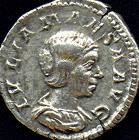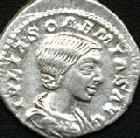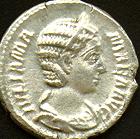 Julia Soaemias (Virtual Catalog of Roman Coins)
Julia Soaemias (Virtual Catalog of Roman Coins)
 Julia Domna (Virtual Catalog of Roman Coins)
Julia Domna (Virtual Catalog of Roman Coins)
 Julia Soaemias (Virtual Catalog of Roman Coins)
Julia Soaemias (Virtual Catalog of Roman Coins)
 Julia Maesa (Virtual Catalog of Roman Coins)
Julia Maesa (Virtual Catalog of Roman Coins)
 Julia Mamaea (Virtual Catalog of Roman Coins)
Julia Mamaea (Virtual Catalog of Roman Coins)

An Online Encyclopedia of Roman Emperors Severan Julias (A.D. 193-235)
Herbert W. Benario Emory University

Julia Domna
Julia Maesa
Julia Soaemias
Julia MamaeaIntroduction and Sources
In the mid 180s, Septimius Severus became governor of the province of Gallia Lugdunensis. At thia point in the emperor's life, the Historia Augusta records, "He had meanwhile lost his wife, and now, wishing to take another, he made inquiries about the horoscopes of marriageable women, being himself no mean astrologer; and when he learned that there was a woman in Syria whose horoscope predicted that she would wed a king (I mean Julia, of course), he sought her for his wife, and through the mediation of his friends secured her. By her, presently, he became a father." (HASeverus 3.9; tr. D. Magie, Loeb Library) So the woman who had enormous influence in the Roman empire for more than twenty years entered history. Julia Domna was mother of Caracalla and Geta, who became joint-emperors after the death of their father. Her sister Julia Maesa had two daughters, each of whom had a son who became emperor. Julia Soaemias was mother of Elagabalus, Julia Mamaea mother of Alexander Severus. For forty-two years, with only a brief interlude, these four women were perhaps more influential in the political life of the empire than any of their imperial predecessors.
The literary sources, although numerous, are limited in value. Chief among them, at least in scope, are the biographies of the Historia Augusta. Though purporting to be the work of six authors in the early fourth century, it is now generally considered to have been produced by one author writing in the last years of that century. Herodian, whose history covered the period 180-238, was a contemporary. So too was Dio Cassius, whose extended history of Rome survives in truncated form. Aurelius Victor, Eutropius, the Epitome de Caesaribus, and other fourth-century Latin sources are extremely brief. Inscriptions, coins, archaeology, papyri, and legal texts help flesh out the literary picture.
Julia Domna (PIR2 I 663) was born about 170 in Emesa of Syria as the younger daughter of Julius Bassianus (PIR2 I 202), priest of the sun god Elagabal. As such, she was part of the local aristocracy. Having come to the attention of Severus because of her promising horoscope (as shown above) she married him, probably in 187, and bore their first child, Bassianus, the future emperor M. Aurelius Antoninus, known as Caracalla, on 4 April 188. About thirteen months later, she gave birth to a second son, Geta.
When Septimius Severus claimed the empire after Didius Julianus had succeeded Pertinax in 193, two serious rivals challenged him, Pescennius Niger in the East and Clodius Albinus in the West. Julia accompanied her husband in the campaign against Pescennius, having been honored with the title mater castrorum. After this successful campaign, there was another campaign in the East, against the Parthians, in 197. Afterwards, she was with Severus on a journey to Egypt and other parts of the empire. She was widely honored with inscriptions throughout this period, and numerous coin issues emphasized her imperial position.
She opposed Plautianus, the praetorian prefect and father-in-law of Caracalla, and was partially responsible for his downfall and his daughter Plautilla's disgrace.[[1]] She was often accused of adultery; nonetheless, the emperor chose to ignore these charges, if true, and the marriage continued.[[2]] Among her passions were literature and philosophy; she gathered writers and philosophers in a kind of salon, and urged Philostratus to write the life of Apollonius of Tyana.[[3]]
She once again accompanied her husband, with the two sons present as well, on campaign, against the Britons in 208. When Severus died at York in early 211, she returned to Rome with Caracalla and Geta, having gained the full title of mater castrorum et senatus et patriae, with the frequent addition of et Augustorum. She persuaded the two sons to share the rule, as the emperor had wished on his deathbed, but, since the brothers hated each other, this arrangement was doomed to failure. In 212, Caracalla murdered Geta while he sought succor in his mother's arms; covered with his blood, she was forbidden by Caracalla to grieve.[[4]]
Her relationship with Caracalla during the six years of his reign was mixed. She had some public duties but largely devoted herself to philosophy.[[5]] She accompanied Caracalla to the east on campaign against the Parthians in 217; when she learned, in Antioch, that he had been assassinated, she resolved upon death, which followed her refusal to take food. Her remains were ultimately placed in Hadrian's Mausoleum, at the insistence of Maesa, her sister. She was deified, and was known as Diva Iulia Domna or Diva Iulia Augusta. She was worshipped in various parts of the empire with local titles, such as Dea Caelestis in Carthage and Venus Caelestis in Puteoli.
Julia Maesa (PIR2 I 678), older sister of Julia Domna, married Julius Avitus (PIR2 I 190) and bore him two daughters, Julia Soaemias and Julia Mamaea. She spent many years in Rome with her sister, evidently never being far from the palace until compelled to leave Rome after the death of Caracalla. Being allowed by Macrinus to keep her great wealth,[[6]] she withdrew to Emesa, her birthplace, where she plotted to supplant the emperor with her elder grandchild, Soaemias' son, by claiming that Caracalla had been the child's father. Using her wealth, she persuaded the soldiers stationed in the city to swear allegiance to the youth, Elagabalus, and in the battle against Macrinus which ensued she restrained fleeing soldiers by leaping from her chariot.
As a consequence, she was hailed as Augusta avia Augusti in early 218. She attempted to restrain the emperor in his peculiar actions and behavior,[[7]] but, at the last, realized that this was an impossible task and transferred her support to her other grandson, Mamaea's son, Alexander Severus. She died not long after Alexander's accession, perhaps as early as 223,[[8]] no later, however, than 226. She was deified after her death, with the title Diva Maesa Augusta or Diva Iulia Augusta.
The elder daughter of Maesa, Julia Soaemias (PIR2 I 704) was born about 180, some eight years before her elder cousin Caracalla. She married Sextus Varius Marcellus (PIR V 192), like her a native of Apamea, who had a long and successful equestrian career before he was adlected into the senate. The couple had numerous children, of whom Avitus, born about 203, became emperor, known as Elagabalus. Soaemias participated in the secular games of 204 among equestrian wives, as a clarissima femina.
With her mother, she plotted to gain the support of the army at Emesa in 218 for her son and was present at the battle which overthrew Macrinus. As the emperor's mother, with the title Iulia Soaemias Augusta, she played a great role in government and administration; she helped establish a senaculum mulierum on the Quirinal, which concerned itself with the behavior of women.[[9]] When Elagabalus lost favor with senate and praetorian guard, she entered the latter's camp to protect her son and was slain with him, on or about March 11, 222. Her body was dragged through the streets and she suffered damnatio memoriae. Her reputation during her lifetime was stained by charges of adultery.[[10]] Indeed, it had been rumored that Caracalla was father of her son.
The younger daughter of Maesa, Mamaea (PIR2 I 649) had a happier, more successful, and lengthier life as imperial mother than her sister Soaemias. She married Gessius Marcianus (PIR2 G 171) and in 208 bore him a son, Bassianus, later known as Alexander Severus. She was with her mother and sister in the East in 218 when her nephew, Elagabalus, was raised to the purple. Alexander was made Caesar in early 222 and soon thereafter became emperor, following the murder of his cousin and aunt. He was fourteen years old and much subject to the control of his grandmother and mother, who effectively governed the empire.[[11]] After Maesa's death, Mamaea remained the dominant figure until her death.
She had seen to it that Alexander received a good education and, once emperor, chose a council of sixteen senators. Her imperial title was Iulia Augusta, mater Augusti nostri et castrorum et senatus et patriae, recalling the titulature of Julia Domna. Her position in the government was confirmed by the title consors imperii. She was charged with avaritia, but otherwise led a life free from scandal. She was recognized as religiosissima, having had conversation with Origen while in the East.[[12]] She had accompanied Alexander thither on campaign against the Persians in 230/31. In 235, she was with him in Germany, at Mainz, when they were assassinated by the troops, with Maximinus Thrax chosen as successor. She suffered damnatio memoriae.
Bibliography
Babelon, J., Impératrices Syriennes (Paris, 1957).
Balsdon, J.P.V.D., Roman Women. Their History and Habits (London, 1962).
Benario, H.W., "The Titulature of Julia Soaemias and Julia Mamaea: Two Notes," TAPA 90 (1959) 9-14.
_____________, "The Date of the Feriale Duranum," Historia 11 (1962) 192-96.
Birley, A., Septimius Severus: The African Emperor (new Haven, 19892).
Bowersock, G.W., "The Circle of Julia Domna," in Greek Sophists in the Roman Empire (Oxford, 1969) 101-09.
Calderini, A., Le Donne dei Severi (Rome, 1945).
De Serviez, J.R., tr. B. Molesworth, The Roman Empresses (London, 1752; New York, 1913) II 192-373.
Ensslin, W., "The Senate and the Army," in CAH 12 (Cambridge, 1939) 57-72.
Kettenhofen, E., Die syrischen Augustae in der historischen Überlieferung (Bonn, 1979).
Kornemann, E., Grosse Frauen des Altertums (Bremen, 1958).
Miller, S.N., "The Army and the Imperial House," in CAH 12 (Cambridge, 1939) 1-56.
Nash, E., Pictorial Dictionary of Ancient Rome (London, 1961-62).
Perowne, S., The Caesars' Wives - Above Suspicion? (London, 1974).
Raepsaet-Charlier, M.-T., Prosopographie des Femmes de l'Ordre Sénatorial (Ier-IIe siècles) (Louvain, 1987).
Stegmann, H., "Julia Mamaea," "Julia Domna," "Julia Maesa," "Julia Soaemias," in Der Neue Pauly, 6 (1999) cols. 3-7.
Turton, G., The Syrian Princesses. The Women Who Ruled Rome, AD 193-235 (London, 1974).
Williams, M.G., "Studies in the Lives of Roman Empresses: I. Julia Domna," AJA 6 (1902) 259-305.
______________, "Studies in the Lives of Roman Empresses: II. Julia Mamaea," in H.A. Sanders, ed., Roman Historical Studies and Institutions (New York, 1904) 67-100.
Footnotes
[[1]] Dio 76.15.6, 77.4.4. The Arch of the Silversmiths in the Forum Boarium in Rome shows a triple damnatio memoriae in both sculpture and inscription; see Nash, I 88-91, ILS 426.
[[3]] Philostratus, Life of Apollonius, 1.3.
[[6]] Herodian 5.3.2, HA Macrinus 9.1.
[[8]] See Benario, "Feriale Duranum."
[[12]]. Eusebius, Historia Ecclesiae 6.21.3-4.
Copyright (C) 2001, Herbert W. Benario. This file may be copied on the condition that the entire contents, including the header and this copyright notice, remain intact.
Comments to: Herbert W. Benario.
Updated: 1 September 2001
For more detailed geographical information, please use the DIR/ORBAntique and Medieval Atlas below. Click on the appropriate part of the map below to access large area maps.